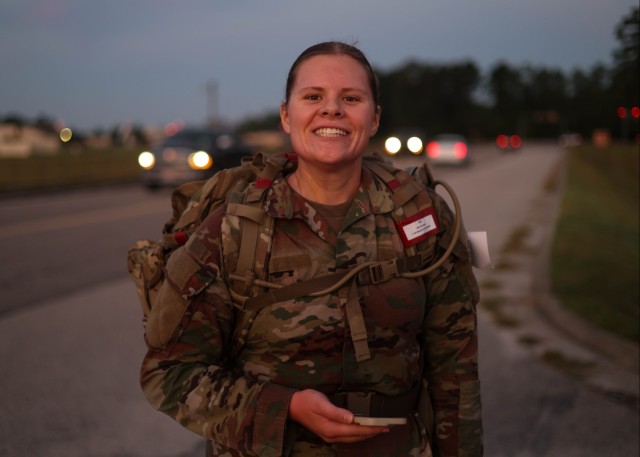Fort Bragg, N.C. - Nearly six hours before sunrise on Sept. 4, roughly 90 Soldiers from across the base donned their rucksacks and tied their boots before embarking on the challenging Norwegian Foot March, an 18.6-mile ruck of unforgiving terrain around Pope Army Airfield.
This demanding event is more than just a test of basic physical endurance; it also pushes Soldiers’ mental capacity to its physical limits. It is a tradition with deep historical roots that fosters esprit de corps, perseverance, and determination among Soldiers.
The origin of the Marsjmerket, also known as the Norwegian Foot March, began in 1915 to prepare Norwegian armed forces recruits for the demands of military service. It remains a key milestone for U.S. Army Soldiers as well. The standard has been well-known to current and former Norwegian marchers and Soldiers: march 18.6 miles with a 25-pound ruck in under four hours and 30 minutes. For more than a century, the march has remained a rite of passage for Norwegian armed forces. Over the last two decades, the march has gained traction among NATO allies and U.S. Army units, underscoring its enduring importance and relevance across borders.
“I signed up for the Norwegian Foot March because, honestly, I just wanted to do it. I had never done a ruck march that long before, so I wanted to challenge myself physically. I thought it would just be fun to do and give it a try,” said Staff Sgt. Jessie Ke, a brigade ammunition manager assigned to the 188th Brigade Support Battalion.
The challenge is seemingly simple. Participants must carry a 25-pound ruck, not including food and water, over nearly 19 miles. The pace demands both stamina and mental toughness, as Soldiers push through fatigue, blisters, and the weight of their rucks.
“For me, the hardest part was pushing through the physical aspects of this ruck; the cramping and the very exhausted legs you have, but it is all mental. You have to just push through,” said Sgt. Jerson Rivera, a wheeled vehicle mechanic assigned to the 188th Brigade Support Battalion.
Preparation is key, but even seasoned runners and marchers say the event forces them to dig deep. For many Soldiers, the Norwegian Foot March is not just a personal test. It is an opportunity to build unit cohesion and honor an international tradition that strengthens NATO ties.
“The feeling of being part of a tradition over 100 years is that you get to be part of all the people that accomplish this 18.6 miles, who push through it, and it is just something I can wear with pride,” said Spc. Kevin Lopez, a network communications systems specialist assigned to the XVII Airborne Corps.
The march also provides Soldiers with a chance to earn a foreign badge, a point of pride that highlights both individual discipline and shared determination.
“It gives the Soldiers a sense of how far they can push themselves. A lot of people do not push themselves that hard, and if they get a sense of, I did 18.6 miles, then 12 miles is easy. Anything is easy,” said Sgt. Noe Roldan-Reyes, a radar repairer assigned to the 188th Brigade Support Battalion.
From its origins in early 20th-century Norway to its place in today’s Army culture, the Norwegian Foot March continues to remind Soldiers of the lasting values of endurance, resilience, and shared purpose. For those who complete it, the badge represents more than a ruck march. It is a symbol of grit and international camaraderie.
The XVIII Airborne Corps trains to dominate in any environment, day or night, leveraging mastery of military operations to overcome any challenge.












Social Sharing